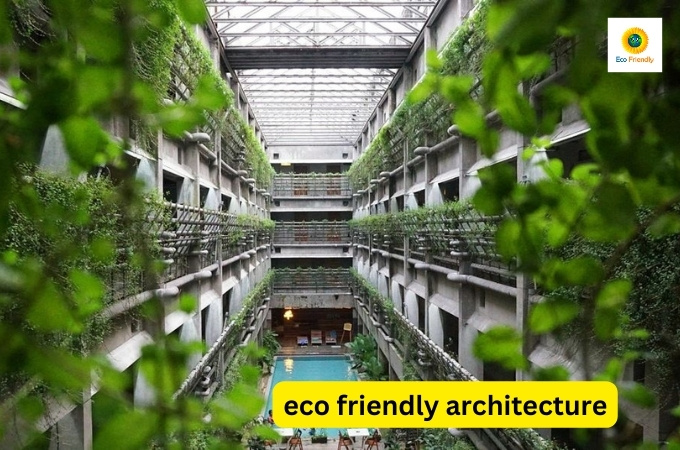eco friendly architecture || ecofriendlyguides.com
Cities around the world are undergoing a new wave of design, one that emphasizes sustainability and reduces our impact on the environment. Known as eco-friendly or green architecture, this type of construction is increasingly becoming an essential part of how we plan, build, and use cities.
From reducing energy to increasing natural ventilation solutions – eco friendly architecture has never been more important for our urban future. In this blog post, we’ll explore what makes up sustainable building projects, why they’re so important for city designs going forward, and some inspiring examples from around the world!
Utilizing natural light to reduce electricity consumption
Natural light is a powerful resource that we often take for granted. Not only does it provide the necessary vitamin D for our bodies, but it can also greatly reduce our electricity consumption. By utilizing windows and skylights, we can let the sun’s rays fill our homes and offices, eliminating the need for artificial light during the day. Natural light also has numerous benefits on our mental health, promoting better moods and productivity. So, the next time you reach for the light switch, take a moment to appreciate the natural light pouring in and consider how it can help reduce your energy usage.
Exploring green roof options for insulation and water conservation
Exploring green roof options for insulation and water conservation presents a sustainable solution for urban spaces. These living roofs offer a multitude of benefits for both the environment and the building’s inhabitants. For instance, green roofs reduce the heat island effect by insulating the building and reducing energy consumption. They also help in water retention by absorbing rainwater, which can be used for irrigation purposes. Additionally, green roofs provide a habitat for wildlife and create a pleasant visual appeal in the urban landscape. The versatility of green roofs allows for various options like intensive green roofs, which can support lawns and even trees, or extensive green roofs that require less maintenance. Therefore, considering green roof options can have a long-lasting impact on the environment and proves to be a wise investment for building owners.
Incorporating eco-friendly materials into building design
As we move towards a more sustainable future, incorporating eco-friendly materials into building design is becoming an increasingly important aspect. Using materials that are eco-friendly can not only reduce the environmental impact of constructions but can also create healthier and more comfortable living spaces for people. There are a variety of green building materials available now, from recycled timber to eco-friendly insulation, and they boast a range of benefits, such as improved thermal performance and reduced energy consumption. As architects and builders become more aware of the impact they have on the environment, incorporating eco-friendly materials into building design will become an essential part of creating structures that are both beautiful and sustainable.
Utilizing sustainable energy sources in construction
In recent years, there has been a growing emphasis on sustainable energy sources and their implementation in construction. From solar panels to geothermal heating and cooling systems, builders are finding innovative ways to incorporate renewable energy while simultaneously reducing their impact on the environment. The benefits of sustainable energy go far beyond just environmental protection. By reducing dependence on non-renewable resources, we can also decrease costs and increase energy security. As the construction industry continues to evolve, it is important for sustainable energy to be at the forefront of that evolution. By utilizing these resources, we can ensure a brighter and more sustainable future for generations to come.
Optimizing air flow with ventilation systems
Breathing in fresh, clean air is crucial for our health and wellbeing, especially in enclosed spaces like our homes or offices. That’s where ventilation systems come in, designed to optimize air flow and ensure a constant supply of fresh air throughout a space. These systems work by removing stale air and exchanging it with fresh air, circulating it through air ducts to create a continuous flow. But it’s not just about maintaining air quality, ventilation systems can also improve energy efficiency by regulating temperature and decreasing strain on heating and cooling systems. By investing in a reliable and efficient ventilation system, you can create a more comfortable and healthier space for yourself and those around you.
Installing low-flow plumbing fixtures for efficient water use
In today’s world, saving water is more important than ever. One effective way to do so is by installing low-flow plumbing fixtures. These fixtures consume less water but provide the same high-quality experience as traditional plumbing fixtures. Plus, they are more environmentally friendly, which means that installing low-flow plumbing fixtures is both a financially and morally responsible choice. So why not take a step towards a sustainable future by making the switch to low-flow plumbing fixtures? Not only will your water bills decrease, but you’ll be doing your part to conserve our planet’s most precious natural resource.
With a shift to green building initiatives, architects and builders must focus on creating sustainable solutions that not only reduce energy consumption but offer health benefits and improved living conditions for occupants. Utilizing natural light, exploring green roof options for insulation and water conservation, incorporating eco-friendly materials into building design, utilizing sustainable energy sources in construction, optimizing air flow with ventilation systems and installing low-flow plumbing fixtures can all contribute to reducing our environmental footprint. The goal is to create efficient buildings that are cost effective and will help to protect the Earth’s valuable resources both now and in the future. As long as we continue to prioritize sustainable solutions when it comes to our buildings, we have a chance of maintaining a healthy environment for everyone.
